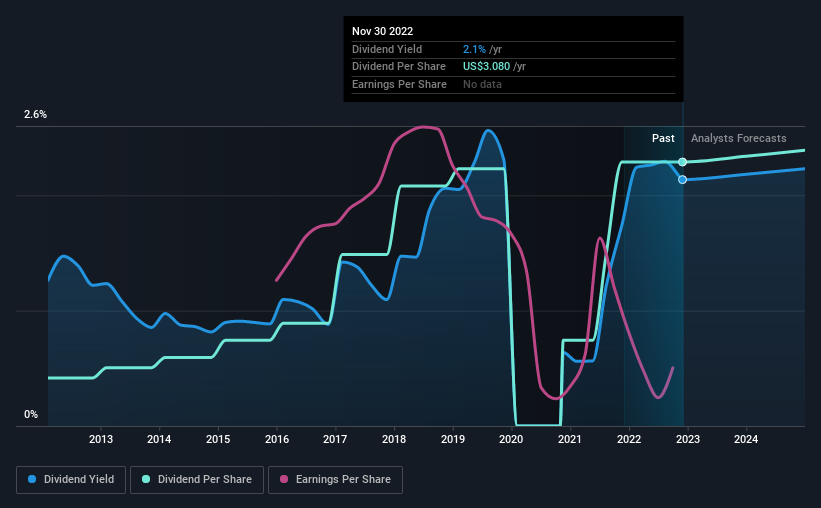Readers hoping to buy Lear Corporation (NYSE:LEA) for its dividend will need to make their move shortly, as the stock is about to trade ex-dividend. The ex-dividend date is one business day before a company’s record date, which is the date on which the company determines which shareholders are entitled to receive a dividend. The ex-dividend date is important as the process of settlement involves two full business days. So if you miss that date, you would not show up on the company’s books on the record date. This means that investors who purchase Lear’s shares on or after the 6th of December will not receive the dividend, which will be paid on the 27th of December.
The company’s upcoming dividend is US$0.77 a share, following on from the last 12 months, when the company distributed a total of US$3.08 per share to shareholders. Calculating the last year’s worth of payments shows that Lear has a trailing yield of 2.1% on the current share price of $144.24. Dividends are an important source of income to many shareholders, but the health of the business is crucial to maintaining those dividends. As a result, readers should always check whether Lear has been able to grow its dividends, or if the dividend might be cut.
See our latest analysis for Lear
Dividends are typically paid from company earnings. If a company pays more in dividends than it earned in profit, then the dividend could be unsustainable. It paid out 79% of its earnings as dividends last year, which is not unreasonable, but limits reinvestment in the business and leaves the dividend vulnerable to a business downturn. We’d be concerned if earnings began to decline. That said, even highly profitable companies sometimes might not generate enough cash to pay the dividend, which is why we should always check if the dividend is covered by cash flow. Over the last year, it paid out dividends equivalent to 648% of what it generated in free cash flow, a disturbingly high percentage. Our definition of free cash flow excludes cash generated from asset sales, so since Lear is paying out such a high percentage of its cash flow, it might be worth seeing if it sold assets or had similar events that might have led to such a high dividend payment.
While Lear’s dividends were covered by the company’s reported profits, cash is somewhat more important, so it’s not great to see that the company didn’t generate enough cash to pay its dividend. Were this to happen repeatedly, this would be a risk to Lear’s ability to maintain its dividend.
Click here to see the company’s payout ratio, plus analyst estimates of its future dividends.
Have Earnings And Dividends Been Growing?
Businesses with shrinking earnings are tricky from a dividend perspective. Investors love dividends, so if earnings fall and the dividend is reduced, expect a stock to be sold off heavily at the same time. Readers will understand then, why we’re concerned to see Lear’s earnings per share have dropped 22% a year over the past five years. Such a sharp decline casts doubt on the future sustainability of the dividend.
Another key way to measure a company’s dividend prospects is by measuring its historical rate of dividend growth. Lear has delivered 19% dividend growth per year on average over the past 10 years. That’s intriguing, but the combination of growing dividends despite declining earnings can typically only be achieved by paying out a larger percentage of profits. Lear is already paying out a high percentage of its income, so without earnings growth, we’re doubtful of whether this dividend will grow much in the future.
Final Takeaway
Is Lear an attractive dividend stock, or better left on the shelf? It’s definitely not great to see earnings per share shrinking. The company paid out an acceptable percentage of its income, but an uncomfortably high percentage of its cash flow over the past year. It’s not that we think Lear is a bad company, but these characteristics don’t generally lead to outstanding dividend performance.
With that being said, if you’re still considering Lear as an investment, you’ll find it beneficial to know what risks this stock is facing. To help with this, we’ve discovered 4 warning signs for Lear that you should be aware of before investing in their shares.
A common investing mistake is buying the first interesting stock you see. Here you can find a full list of high-yield dividend stocks.
Have feedback on this article? Concerned about the content? Get in touch with us directly. Alternatively, email editorial-team (at) simplywallst.com.
This article by Simply Wall St is general in nature. We provide commentary based on historical data and analyst forecasts only using an unbiased methodology and our articles are not intended to be financial advice. It does not constitute a recommendation to buy or sell any stock, and does not take account of your objectives, or your financial situation. We aim to bring you long-term focused analysis driven by fundamental data. Note that our analysis may not factor in the latest price-sensitive company announcements or qualitative material. Simply Wall St has no position in any stocks mentioned.
Join A Paid User Research Session
You’ll receive a US$30 Amazon Gift card for 1 hour of your time while helping us build better investing tools for the individual investors like yourself. Sign up here
